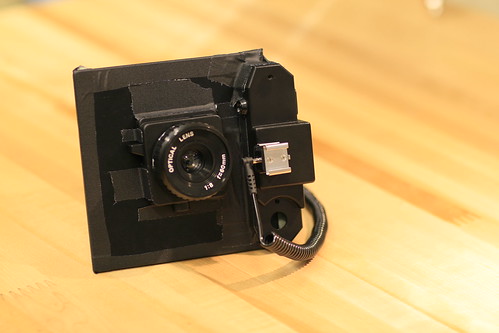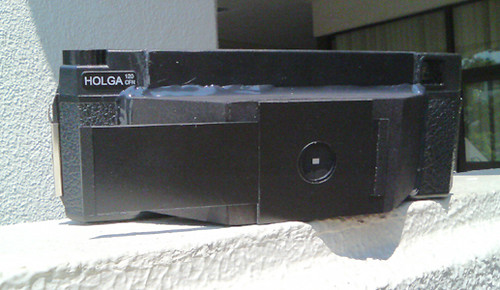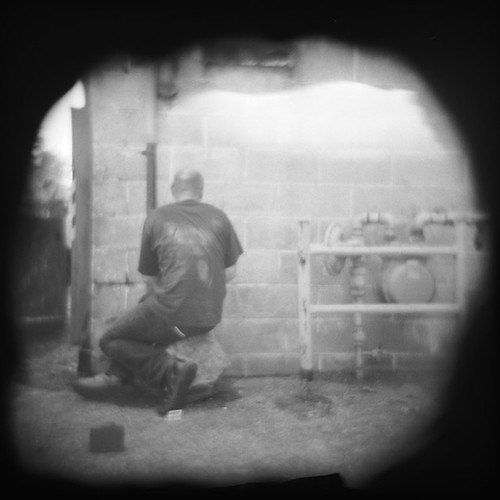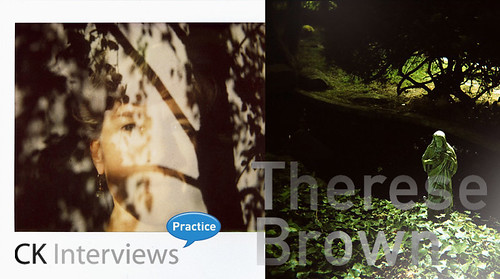Holga-Cam of the Apocalypse by RoFi Mike.
Made without any cutting, the “Holga-Cam of the Apocalypse” is the product of my love for low-tech experimentation and obsession with cutting edge technology. There are more descriptions and photos of the camera itself in this set, and photos from the camera in the Holgapocalyptiphotos set.
The camera is built from:
1 – Holga 120N camera body (retail: $25)
1 – Phase One P25 Digital Back (retail: $24,000)
1 – Horseman lens board (thus the current name)
1 – Foot of Black Gaff Tape…
You may ask yourself “why?” That is the wrong thing to ask.
Pictures taken with the camera are here.
Tag: toy camera
2 new Holga converter lenses & fisheye viewfinder
Holga just officially released two plastic lenses that attach over the existing Holga lens to change the focal length
The two tele-converter lenses, models HT-25 (tele lens) and HW-05(wide lens) fit onto you holga and either lengthen(HT-25) or shorten (HW-05) the focal length, therefore creating a tele or wide lens.
Another new release is a fisheye viewfinder that sits on top of your holga enabling you to see the subject ‘fisheyed’ before taking the photo. This viewfinder is a companion piece to the holga fisheye lens.
More info at Holgablog
Interview with toy camera photographer Larry Treadway
Tread ain’t bad. He starts:
Analog photography is the disconnect from my digital work life. Bad plastic cameras are my kind of rebellion to the glut of computers, monitors and peripherals required for me to make a living. I’ve tried to be an artist of some sort most of my life, from photography to a stint screaming in a loud punk rock band I’ve had that need to express something…basically I’ve failed at a lot of different things. Trying to be a decent father, Internet instigator and creative-type using photography as a tool to help that along…
Continue reading on Petapixel
Check out Tread’s work at his web site, gotreadgo, and here on Flickr.
Toy camera photography workshop with Kurt Norlin, Oregon, US
Workshop flyer:
Tired of all the technicalities of high-end cameras? Toy Camera photography is photography at its most basic, freeing up the photographic artist to concentrate on the creative side of image making. Often made with a plastic lens and limited controls, these simple devices produce images that have unique visual qualities. The students in this workshop will gain an overview of toy camera photography, and how to properly set up and load the camera for the best results. Cameras will be available or bring your own. This is very much a hands on class. No prior darkroom experience needed, just a sense of play, and a desire to see the world in a new way.
OCT 10-11, 2009 * VISUAL ARTS CENTER * NEWPORT, OREGON
THE WORKSHOP IS LIMITED TO SEVEN STUDENTS
Sat 10am-noon Historical overview, setting up the toy camera,
1pm-5pm: Shoot: Nye Beach, print contact sheets.Sun 9am-noon: Shoot: Newport Waterfront
1pm-4:00pm Print contact sheets.Cost: $100.00 + 40.00 (lab)
A $50.00 non-refundable deposit can be made through PayPal using the email address below as the account name, or by check. Please send checks to:
Kurt Norlin / 422 Railroad St. SE / Albany, OR 97321 / (541) 967-6892
The balance is due at the start of the workshop. Film (five rolls of B+W), processing, and contact sheets are included in the lab fee.
Kurt is a graduate of Central Washington University (BA, MA) and the University of Oregon (MFA). He has been working with toy camera photography since 1993 and taught at Linn-Benton Community college from 1994 to 2009. To contact Kurt: norlink1@hotmail.com. If you would like to see some of his toy camera work go to kurtnorlinphotography.com and check out the Alt Viz gallery.
Visual Arts Center
777 NW Beach Street
Newport, Oregon 97365
(Nye Beach Turnaround)
Plastic CameraWorks toy camera photography show, NC, US
Toy camera photography goodness at Rebus Works in Raleigh, NC, US! Includes work by the badass Ron Flory. Don’t miss it!
Homemade 6×17 stretch Pinholga
Shikihan made this insane 6×17 "Limousine" pinhole camera out of a Holga! You can see two test shots made with it in Tokyo here and here on Flickr.
She’s made a bunch of other cool pinhole cameras (and makes great photos with them), check them out!
Diana spool tension hack

Check out freerobotpants‘ simple and effective hack for adding spool tension to Diana toy cameras: tape!
Tin-foil-lined Holga
Ever wonder what happens when you line a Holga with aluminum foil? Me too!
I crinkled the crap out of it to hopefully get lots of light bouncing around in different directions, and lined the camera, shiny side out. The irregular vignette is because I wasn’t very careful about leaving the edges of the light path clear.
I expected the lowered contrast, but was thinking I might get some random specular-type highlights. Nope. Of the whole roll, this is the only frame that had a visible artifact (the white wavy form near the top). But this does show that you can easily control the shape of your vignette, just take the back off and put some crap around the square hole you can see the shutter through.
If you care, this is Kodak T-Max 100 developed in Diafine.
How to fix a Holga’s corner double exposure issue
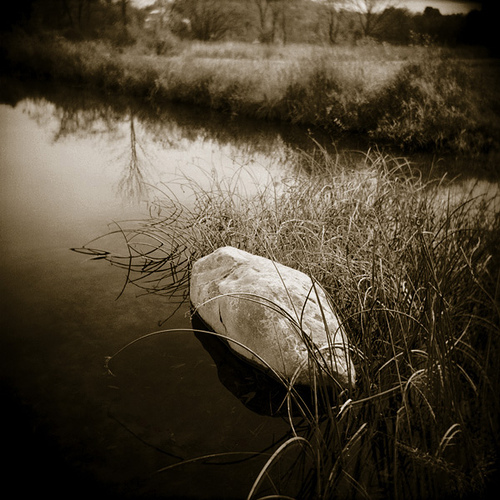
There is a fairly common shutter issue with Holga toy cameras that creates a slight double exposure in the bottom right corner of the frame (see above).
See what causes it and find out how to fix it at Squarefrog’s excellent Holga resource site, Holgas Online.
Interview with Therese Brown
Chris Keeney talks to pinhole/Holga/Polaroid experimental photographer Therese Brown as part of his excellent ongoing series of interviews with fine art photographers.
You can see Brown’s work at her Web site, ThisIsWhatISee.com as well as on Flickr.
This one’s a must-read, so do it at ChrisKeeney.com.
